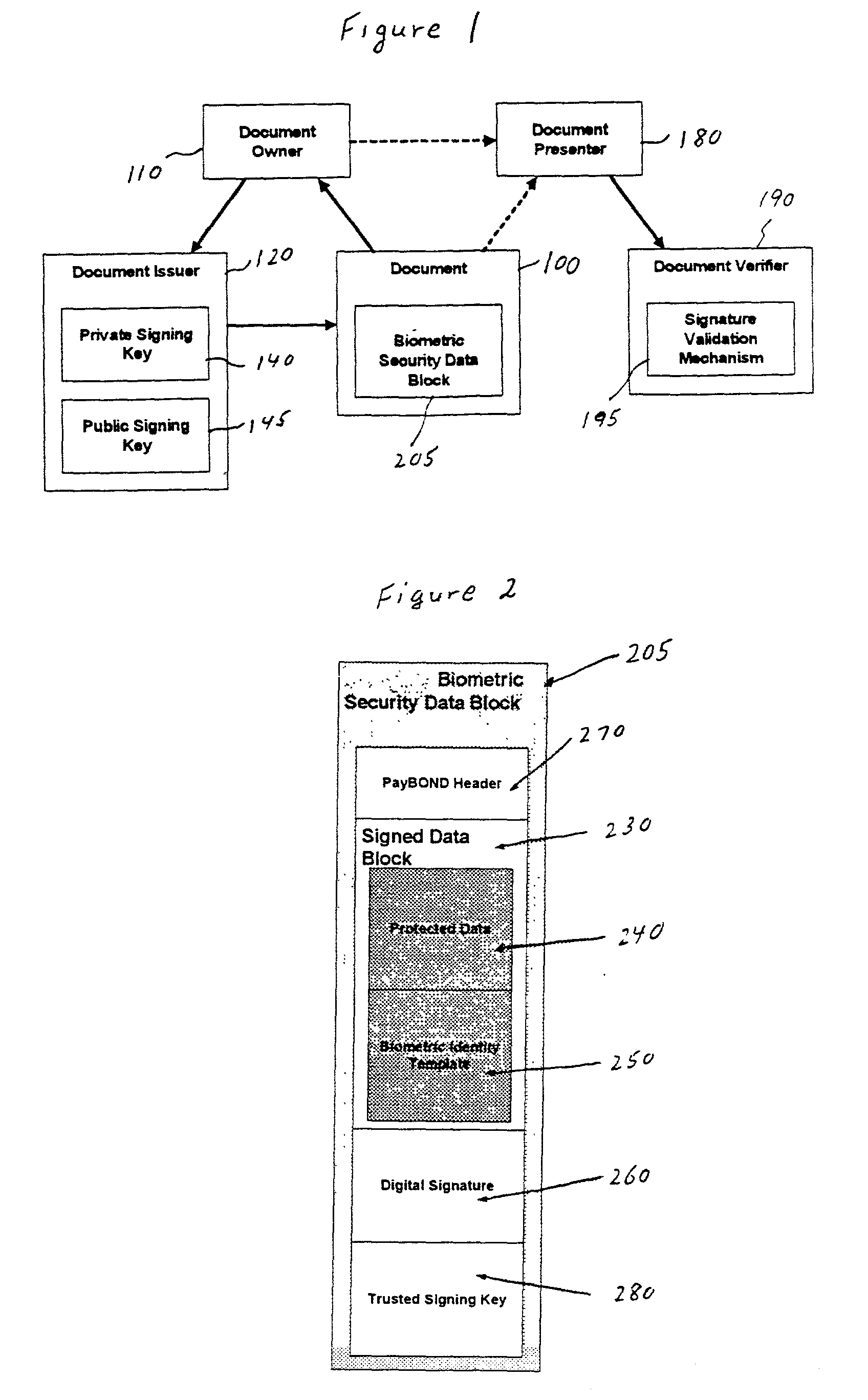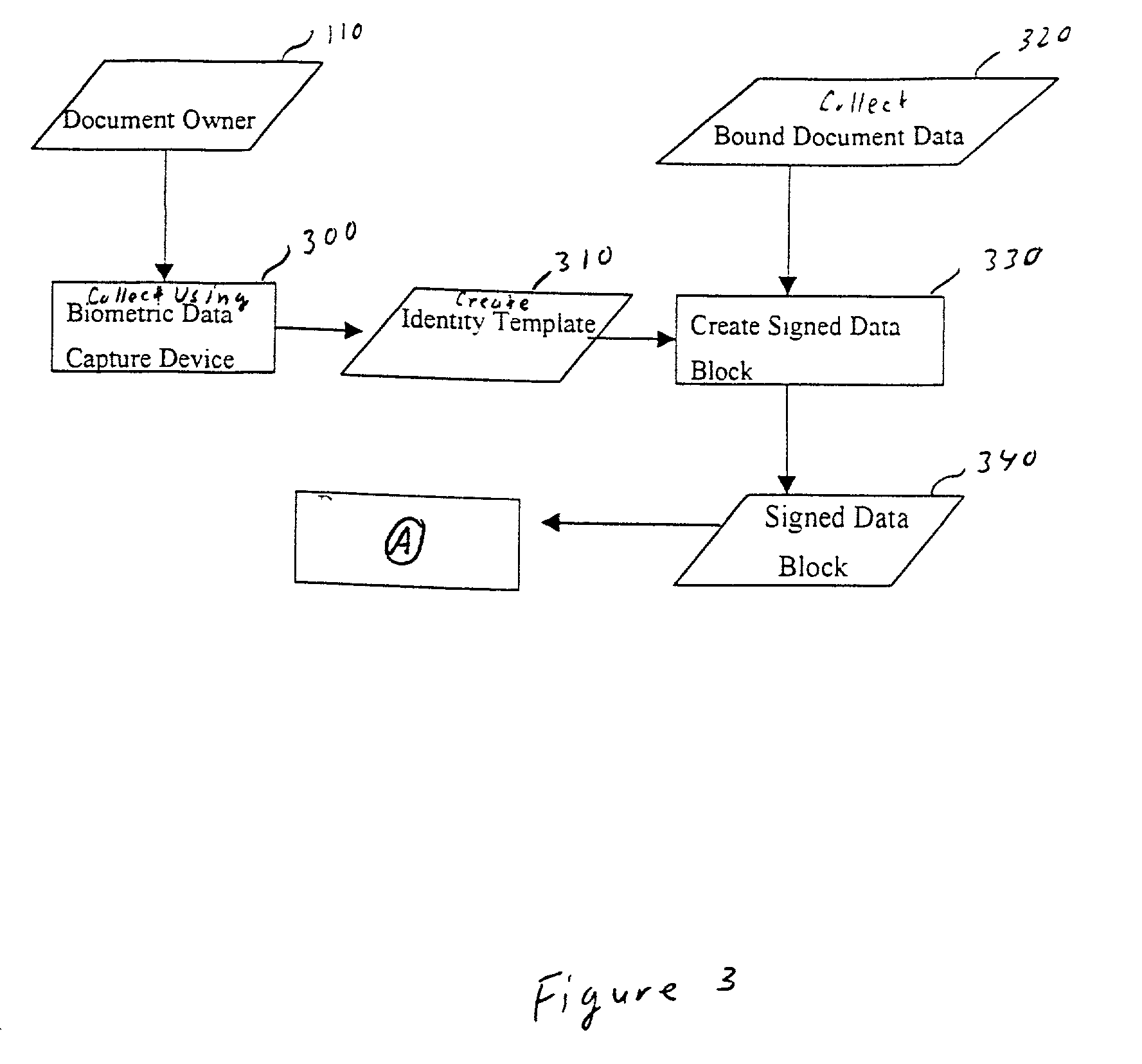Creating counterfeit-resistant self-authenticating documents using cryptographic and biometric techniques
a cryptographic and biometric technology, applied in the field of creating counterfeit-resistant self-authenticating documents using cryptographic and biometric techniques, can solve the problem that documents can easily be forged or altered
- Summary
- Abstract
- Description
- Claims
- Application Information
AI Technical Summary
Benefits of technology
Problems solved by technology
Method used
Image
Examples
first embodiment
[0061] The creation of a counterfeit-resistant, self-authenticating document 100 in accordance with the invention will be explained below, which reference to FIGS. 1, 2, 3 and 4.
[0062] Biometric data is captured from the document owner 110 by the document issuer 120 utilizing a biometric data capture device (see step 300 in FIG. 3). For example, the biometric data capture device may correspond to a retinal scan device that obtains an imprint of a retina of the document owner 110, whereby the imprint is digitized into a sequence of data bits that represent a pictorial representation (e.g., pixels in a matrix) of the retina. Alternatively, a fingerprint scanner can be used to scan information from one or more fingers of the document owner 110. Alternatively, a photograph of the document owner 110 is taken, which is converted to digital form. Other types of biometric data that can be used have been described previously (such as DNA profile, voice print, etc.).
[0063] Next, the biometric...
second embodiment
[0065] Also, in the invention, a personal key known to the document owner 110 (and not typically known by others), such as the maiden name of the document owner's mother, can be collected by the document issuer 120 during the document creation process and stored as part of the protected data 240.
[0066] Next, the protected data 240 and the biometric data 250 are packed into a contiguous signed data block 230, as shown in steps 330 and 340 in FIG. 3. The signing of the data block 230 is preferably done by generating a digital signature 260 by using the private signing key 140 of the document issuer 120. In one embodiment, the protected data 240 is stored as a first part of a data sequence in the signed data block 230, and the biometric data 250 is stored as a second part of a data sequence in the signed data block 230, with a delimiter preferably provided therebetween to be used to separate these two parts when the document is to be authenticated. The order can be switched in a differ...
third embodiment
[0091] In the invention, a challenge-response handshake procedure is used between the document issuer 120 and the document issue mechanism to ensure that the document issuer 120 is indeed who he or she appears to be, as well as to prove to the document issuer 120 that the document issue mechanism has not been tampered with. The document issue mechanism provides the document 100, such as a passport, with a bar code or other type of authentication code imprinted or otherwise affixed thereto, in accordance with the present invention.
[0092] In the third embodiment, upon turning on the document issue mechanism, the document issuer 120 types in a password known only to the document issuer 120, to thereby allow access to the document issue mechanism to be able to issue valid documents. The document issuer 120 can request a "dump" of information from the document issue mechanism, such as version number of software stored therein and / or the number of the last issued document, in order that t...
PUM
 Login to View More
Login to View More Abstract
Description
Claims
Application Information
 Login to View More
Login to View More - R&D
- Intellectual Property
- Life Sciences
- Materials
- Tech Scout
- Unparalleled Data Quality
- Higher Quality Content
- 60% Fewer Hallucinations
Browse by: Latest US Patents, China's latest patents, Technical Efficacy Thesaurus, Application Domain, Technology Topic, Popular Technical Reports.
© 2025 PatSnap. All rights reserved.Legal|Privacy policy|Modern Slavery Act Transparency Statement|Sitemap|About US| Contact US: help@patsnap.com



